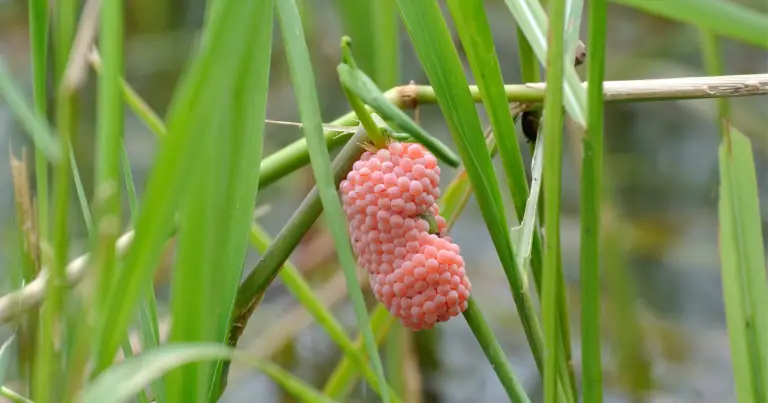Do Snails Poop?

Do snails poop? You may have wondered about this rather peculiar question; the answer is yes, snails poop. Like all other animals, snails must expel waste to maintain a healthy digestive system. Understanding how snails’ unique physiology plays a role in their bowel movements can be intriguing.
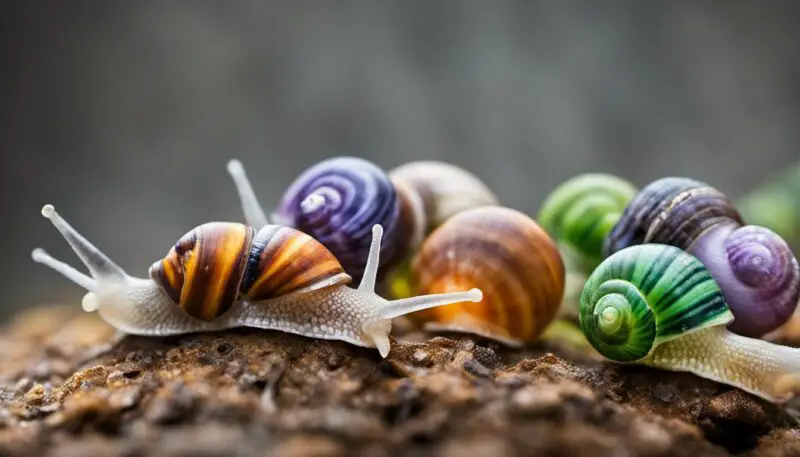
A snail’s waste, or poop, is small and stringy, and its appearance can vary based on the snail’s diet. The color of snail poop is highly dependent on what they eat, as it generally blends with the consumed material. You might find snail poop on leaves in your garden if they have visited or even in the mud where they have been feeding.
Snail poop originates from the anus inside their shells towards the front of their bodies. It comes out as a long, thin, sticky tube and eventually drops to the ground. Now that you know snails do indeed poop, you may find yourself paying closer attention to these fascinating creatures and the evidence they leave behind.
Contents
Table of Contents
Basic Understanding of Snails

Digestive System of Snails
Like all animals, Snails have a digestive system that allows them to absorb nutrients from their food and pass waste out of their bodies. The waste is collected in a sac called the cecum at the end of the intestine. Snails poop from their anus, which can be found inside their shell towards the front of their body, on the same side as their head1.
When a snail poops, the poop comes out of the anus inside the shell, then slides out the side of the shell2. The appearance of snail poop is a combination of mucus and hard, brown pellets. It can vary in color and size, depending on the species of snail3.
One unique feature of snails is their breathing hole, which is connected to their lungs. Land snails breathe air through this hole, getting oxygen from the environment to support their internal organs4.
Types of Snails and Their Habitats
There are thousands of snail species whose habitats can range from land to freshwater and marine environments. Land snails typically have a shell for protection, but marine and freshwater snails often have adapted shells to fit their specific environment.
One thing to keep in mind is that the majority of snail species are herbivores5. Their main diet includes feeding on living plants, such as leaves, fruits, and mushrooms. In the wild, they rely on their sense of smell to find food, using the tentacles on their heads to detect chemical signals in the air6.
Another interesting fact about snails is that they are hermaphrodites, meaning they have both male and female reproductive organs. This allows them to reproduce without a mate, making it easier to propagate their species in their various habitats7.
In summary, understanding snails requires knowledge of their digestive system, internal organs, breathing holes, and the different types of snails and their habitats. Be aware of their herbivorous nature and hermaphroditic tendencies to understand these fascinating creatures comprehensively.
Snail’s Diet
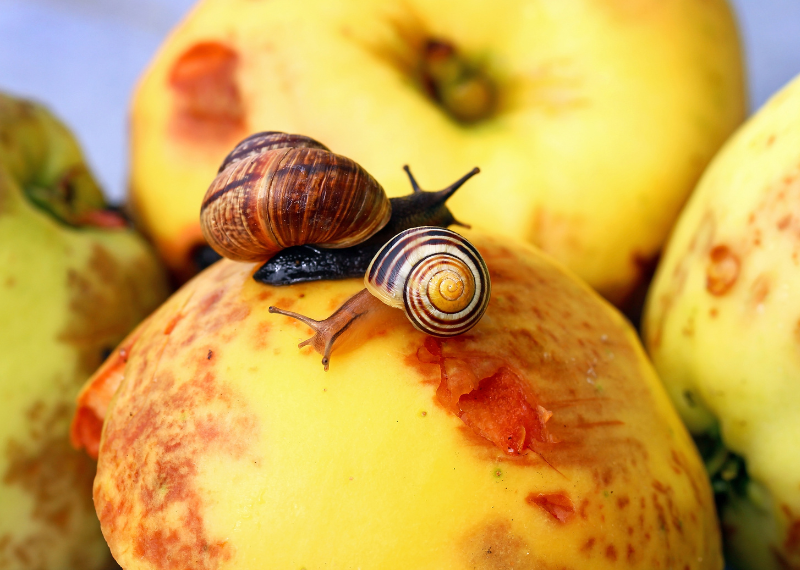
As a snail owner or someone interested in these fascinating creatures, you might wonder what snails eat and how it affects their daily life. This section will explore the snail’s diet to understand their eating habits better.
Snails are mostly herbivores, which means they primarily feed on plants. Their diet includes leaves, like lettuce, cabbage, and herbs. They also enjoy munching on grass and other vegetation found in their natural habitat. However, some snails are omnivores, consuming both plant and animal matter. Omnivorous snails might eat other small insects, larvae, or even other snails in addition to their plant-based diet.
In addition to leaves and plants, snails also love eating fruit. Soft fruits like ripe tomatoes, melons, and berries appeal to them. You can also provide them with pumpkin, zucchini, or cucumbers as part of their nutritious diet.
To maintain the health and strength of their shells, snails require an ample amount of calcium. They often consume chalk from rocks or other calcium-rich substances to fulfill this requirement.
It is essential to provide your snails with a diverse and balanced diet. Offering them a range of plants, herbs, and fruits ensures they receive the necessary nutrients to thrive and grow. Always avoid feeding them harmful foods or substances that could negatively impact their health.
By understanding the dietary needs of snails, you can better care for these unique creatures and ensure they live a healthy and satisfying life.
Snail’s Pooping Process
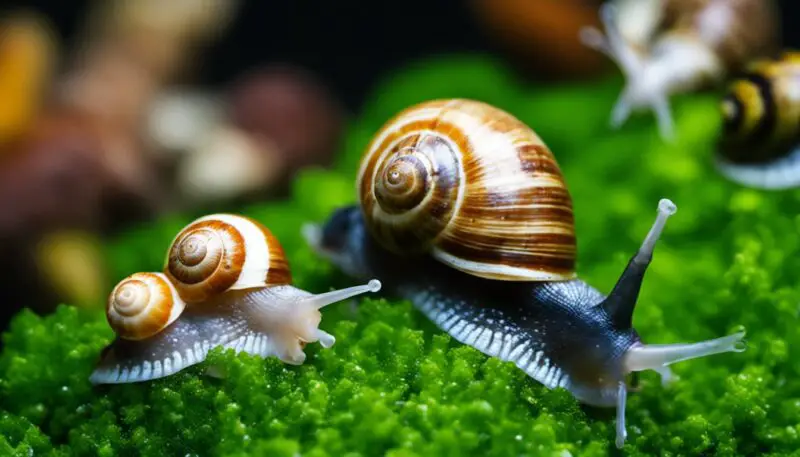
To understand the pooping process of snails, it’s essential to know how their digestive system works. Snails have a similar digestive system to humans, starting from their mouth, leading to the stomach, and eventually expelling waste through the anus.
As you observe a snail, you may notice that its anus is located inside the shell, towards the front of its body. This positioning ensures the efficient expulsion of waste. When it is time for the snail to poop, waste slides out from the anus and exits the shell’s side, dropping to the ground. The feces often appear as a stringy, sticky tube whose color can vary based on the snail’s diet.
The snail’s digestion process begins when they consume food. The food travels from the mouth down to the intestines, where nutrients are absorbed. Water plays a crucial role in snail digestion, breaking down food particles and ensuring smooth transit through the intestinal tract.
While air helps control the speed of waste passing through the snail’s rectum, the digestive system processes and breaks down the food to create waste products. Once the waste reaches the anus, the snail can effectively expel it from their body.
There isn’t a specific frequency at which snails poop, as it varies depending on their diet and digestive health. However, it is natural for snails to defecate periodically as part of their biological function to expel waste products generated during digestion.
Your understanding of the snail’s pooping process is now more comprehensive. You comprehend how their digestive system processes food and how their unique anatomical features allow waste expulsion. Remember that the color and frequency of snail feces may vary based on the individual snail’s diet and overall health.
Characteristics of Snail Poop

Snail poop possesses certain characteristics that make it easily identifiable. When you observe snail poop, you’ll notice it is stringy in texture. This long and rope-like shape is a shared feature among all snail species. As the poop dries up, it transforms into a more constricted C-shape1.
The color of snail poop primarily depends on the food that the snail consumes. Being herbivores, snails feed on leaves, usually green or brown shades. Consequently, snail poop often appears in shades of green or brown but can also be pale2. The wetness or dryness of the poop depends on the moisture content of the snail’s environment and the food they eat. In a moisture-rich habitat, the poop is likely to be wetter, while in a drier environment, it may appear dry.
Another important aspect of snail poop is its presence in the garden. Did you know that snail poop is a natural source of essential plant nutrients? Rich in Nitrogen, Phosphorus, and Potassium, snail poop acts as a fertilizer, providing these primary nutrients to the plants3. This means that snails in your garden can contribute to your plants’ health through their fecal matter. Knowing these characteristics, you can identify snail poop in your garden or enclosure.
In summary, the characteristics of snail poop to keep in mind include its stringy texture, C-shape when dried, and its green or brown appearance, depending on the color of the food consumed by the snail. Lastly, remember that snail poop serves as a natural fertilizer, providing essential nutrients to the plants in your garden.
Nutritional Components in Snail Poop

When considering the nutritional components of snail poop, it is important to understand its various nutrients and minerals. Some of the main constituents of snail poop include calcium, nitrogen, potassium, phosphorus, and other trace minerals. These elements are essential for maintaining healthy soil and providing nourishment to plants.
As you may know, snails primarily consume plant matter. Their diet comprises leaves, stems, fruits, and decaying plant material. As snails digest these materials, their poop becomes enriched with the nutrients they’ve taken in. This makes snail poop an ideal fertilizer for your garden.
Calcium is abundant in snail poop, crucial in maintaining their shells. This mineral is essential for building strong plant cell walls, making it a beneficial addition to the soil.
In addition to calcium, snail poop contains nitrogen, potassium, and phosphorus – essential macronutrients required for healthy plant growth. Nitrogen promotes foliage growth by aiding in chlorophyll production, the pigment responsible for photosynthesis. Potassium helps regulate water balance in plants, prevents wilting, and promotes disease resistance. Phosphorus is required for root development, growth, and the formation of flowers, fruits, and seeds.
Snail poop also provides a source of trace minerals, such as zinc, manganese, and iron. These elements are crucial for plants to grow healthily and develop strong immune systems. They are vital in various biological processes, including enzyme production, nutrient absorption, and resistance to pests and diseases.
By utilizing snail poop as a fertilizer, you can optimize the nutrient content of your garden soil, leading to healthier and more vibrant plants. Remember to be cautious and never apply too much fertilizer, as excessive amounts may lead to nutrient imbalances and other potential issues.
HOW SNAILS POOP? watch this
Significance of Snail Poop in Ecosystem
As a gardener or a nature enthusiast, you might be curious about the role snail poop plays in the ecosystem. Snail poop, though small in quantity, is an important link in the ecological balance.
Firstly, snail poop contributes to the decomposition process of organic matter. Snails primarily feed on living and decaying plants, consuming their nutrients from leaves and fruits to mushrooms. When snails excrete, they release waste material back into the environment. This waste is rich in nutrients, which can benefit other plants and organisms in the area.
In addition to its role in the decomposition process, snail poop helps recycle nutrients in the ecosystem. They generate nutrient-rich waste by breaking down dead plant and animal matter through their digestive systems. This waste is then utilized by other living organisms, such as plants and microorganisms, ensuring the smooth cycling of nutrients within the food web.
Furthermore, snail poop may indirectly benefit other animals in your garden or the local ecosystem. When snails consume algae and decaying plant matter, their waste products can serve as a food source for many small organisms, such as insects, worms, and microorganisms. These small creatures then become an essential part of the food chain, serving as a primary source of nutrition for various larger animals.
In conclusion, snail poop plays a vital role in maintaining the balance of the ecosystem. Although often overlooked, its significance should not be underestimated as it contributes to the recycling and redistributing of essential nutrients within the environment, ultimately supporting the growth and health of the plants and animals that share your garden or the land around you. So, the next time you encounter a snail in your garden, remember that their seemingly insignificant poop is doing its part in sustaining the intricate web of life.
Interactions of Snail Poop with Humans and Pets
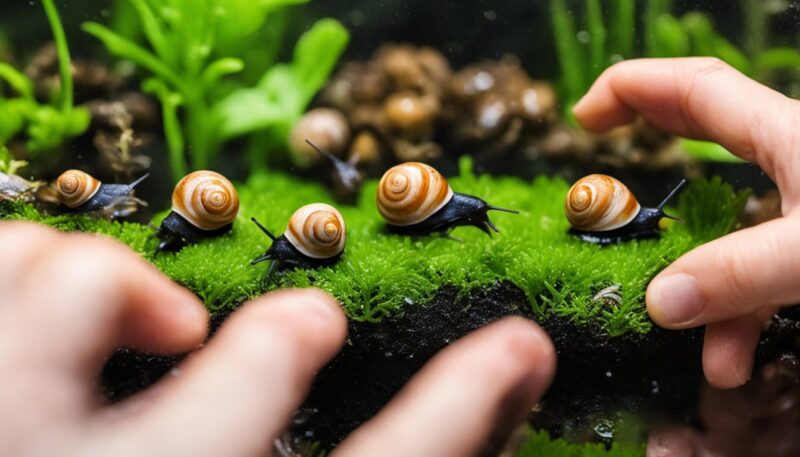
Regarding snail poop, it’s essential to consider how it can affect you and your pets. One of the primary concerns that you may have is whether snail poop is toxic or harmful to humans and animals.
First, let’s examine the effect of snail poop on humans. Generally, snail poop isn’t considered toxic or hazardous to humans. However, it’s still advisable to handle it with care and cleanliness. When dealing with snail poop, always wear gloves and wash your hands thoroughly after removing it from your garden or home. This proper hygiene practice is vital, as some snails, particularly those found in tropical regions, can carry parasites that cause diseases like schistosomiasis. Although rare, staying cautious and maintaining cleanliness is essential to avoid possible infections.
As for pets, the impact of snail poop on them can vary depending on the type of pet and its overall health. Most pets, like dogs or cats, are unlikely to react adversely to snail poop. However, there may be potential risks if your pet ingests large snail poop. In that case, it’s best to monitor their behavior and consult a veterinarian if you notice any signs of illness.
To keep your pets safe from potential harm, follow these guidelines:
- Keep your garden clean and clear of snail poop, reducing the chances of your pets encountering it
- Regularly clean areas where you’ve seen snails or their droppings
- Supervise your pets when they’re outside, and promptly remove any snail poop they might encounter
In conclusion, snail poop is generally not harmful to humans or pets. However, taking proper precautions and ensuring cleanliness are crucial to avoid potential health risks. Always wear gloves, wash your hands, and watch your pets to ensure their safety around snail poop.
Preventive Measures against Snails
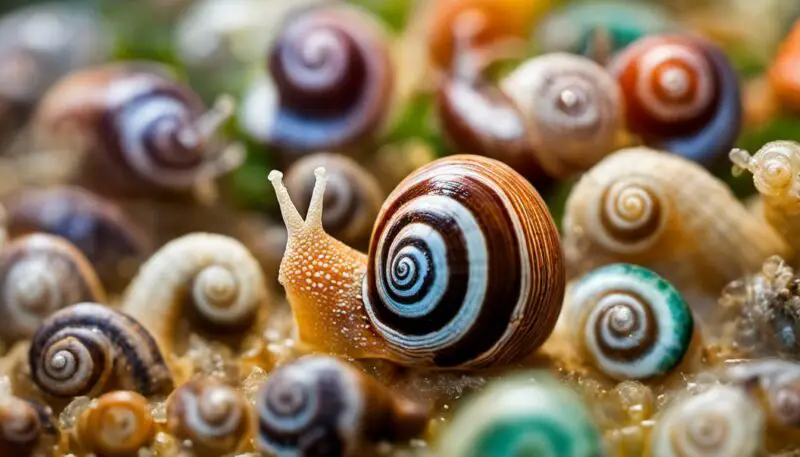
Maintaining a healthy environment for your aquatic pets and plants is crucial, and controlling snail populations is important. Here are some preventive measures that can help you keep snails at bay.
First, carefully inspect any new plants or decorations you introduce to your freshwater or saltwater tank. Snail eggs and baby snails can easily hitch a ride on these items, making their way into your aquarium. Make sure to rinse and clean any new additions thoroughly, and if possible, quarantine them briefly before adding them to your tank.
Another effective way to control snail populations is by introducing natural predators to your tank. Some fish and other aquatic creatures are known for feeding on snails and can help keep their numbers in check. For example, zebra loaches, assassin snails, and dwarf pufferfish are efficient snail predators. However, before introducing them, it’s vital to research any predator’s compatibility with your existing tank environment and inhabitants.
You should also make sure not to overfeed your aquatic pets. Excess food left to rot in the tank contributes to algae growth and provides an abundant food source for snails. By controlling the food supply, you directly affect the snail population in your tank. Always feed your fish with the appropriate amount of food, and consider investing in a siphon to remove any waste or uneaten food from your tank’s substrate.
Regular tank maintenance is another key factor in snail prevention. Clean your tank regularly by removing dead plants, algae, and other organic waste. Regular water changes ensure that your tank’s water maintains suitable conditions for your aquatic inhabitants and is less inviting for unwanted snails.
Finally, snail traps can help you monitor and control the snail population. There are commercially available traps, or you can even create your own using a small container and bait, such as lettuce leaves or pellets. Place the trap in your tank overnight and check it the following morning. Snails attracted to the bait can be easily removed from your tank.
By following these preventive measures, you can effectively manage the snail issue in your tank and ensure a thriving environment for your aquatic plants and animals.
Frequently Asked Questions
Where do snails excrete waste?
Snails excrete waste through their anus, which is located inside their shell. All the internal organs of a snail, including the anus, are housed within the shell, making it the primary site for waste removal source.
How often do snails poop?
The frequency of snail waste excretion varies depending on factors such as their diet and environment. Not all snails have a specific frequency, but they typically poop as needed based on their food consumption.
What does snail poop look like?
Snail poop has a rope-like appearance, tending to be long and slender. Once it dries, it becomes thinner, and the ends of the strand start to curl inwards, creating a C-shape source.
Is snail waste harmful to humans?
In general, snail waste is not harmful to humans. However, it’s essential to maintain hygienic conditions in environments where snails are present, such as aquariums, as some pathogens may thrive in these settings and pose potential risks to human health.
What color is snail waste?
The color of snail waste can vary depending on their diet. It may range from greenish-brown to white. Snails with a calcium deficiency or those consuming a large quantity of cuttlebone in combination with too little vegetation may have a white poop source.
Do snails poop in aquariums?
Yes, snails do poop in aquariums. They excrete waste just like any other living creature in the tank. Maintaining proper water quality, filtration, and cleanliness ensures a healthy aquatic environment for all inhabitants, including snails.

![How Big Do Assassin Snails Get? [Full Guide To Healthy Assassin Snails]](https://allourcreatures.com/wp-content/uploads/2021/11/assassin-snails-768x519.jpg)




